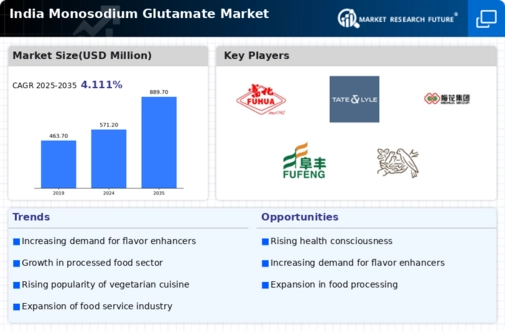The monosodium glutamate market in India is characterized by a competitive landscape that is increasingly shaped by innovation, strategic partnerships, and regional expansion. Key players such as Ajinomoto (Japan), MSG Co., Ltd. (China), and Fufeng Group (China) are actively pursuing strategies that enhance their market presence. Ajinomoto (Japan), for instance, focuses on product innovation and sustainability, aiming to meet the growing consumer demand for natural flavor enhancers. Meanwhile, MSG Co., Ltd. (China) emphasizes supply chain optimization and cost leadership, which allows it to maintain competitive pricing while ensuring product availability. Fufeng Group (China) is also expanding its footprint through strategic acquisitions, thereby enhancing its production capabilities and market reach. Collectively, these strategies contribute to a moderately fragmented market structure, where competition is driven by both price and product differentiation.
In terms of business tactics, companies are increasingly localizing manufacturing to reduce logistics costs and improve supply chain efficiency. This approach not only enhances responsiveness to market demands but also aligns with the growing trend of sustainability, as local production often results in lower carbon footprints. The competitive structure of the market remains moderately fragmented, with several players vying for market share, yet the influence of major companies is significant in shaping industry standards and consumer preferences.
In October 2025, Ajinomoto (Japan) announced the launch of a new line of organic monosodium glutamate products aimed at health-conscious consumers. This strategic move is likely to position the company favorably in a market that is increasingly leaning towards natural and organic food products. By tapping into this growing segment, Ajinomoto (Japan) not only diversifies its product offerings but also strengthens its brand image as a leader in sustainable food solutions.
In September 2025, MSG Co., Ltd. (China) revealed plans to invest $50 million in expanding its production facilities in India. This investment is expected to enhance the company’s production capacity by 30%, thereby improving its ability to meet rising domestic demand. Such a significant capital infusion indicates MSG Co., Ltd.'s commitment to the Indian market and its strategy to leverage local production for competitive advantage.
In August 2025, Fufeng Group (China) entered into a strategic partnership with a local Indian food manufacturer to co-develop new flavoring products. This collaboration is anticipated to facilitate knowledge transfer and innovation, allowing Fufeng Group (China) to better cater to local tastes and preferences. The partnership underscores the importance of local insights in product development, which is crucial for success in the diverse Indian market.
As of November 2025, the competitive trends in the monosodium glutamate market are increasingly defined by digitalization, sustainability, and the integration of advanced technologies such as AI. Companies are forming strategic alliances to enhance their innovation capabilities and streamline operations. The shift from price-based competition to a focus on technological advancement and supply chain reliability is evident. Moving forward, competitive differentiation will likely hinge on the ability to innovate and adapt to changing consumer preferences, with a strong emphasis on sustainability and quality.
















Leave a Comment